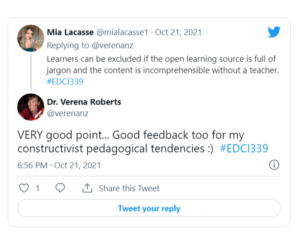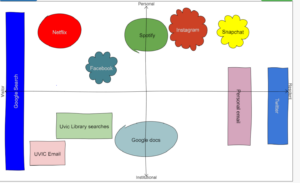For Topic #3, I learned how to actively engage in sharing, evaluating, and creating open educational resources. I completed three individual activities including participating in a fast-paced Twitter chat, editing a Wikipedia page, and creating a Visitors and Residents (VR) map. When reflecting upon the Twitter chat, I can see how this was a form of critical pedagogy through vconnecting. Maha Bali (2017) discussed how virtual connecting (vconnecting) is a powerful tool for students to have reciprocal relationships with teachers in their learning. This is in contrast to a traditional classroom where the pedagogy is framed from a top-down approach, with teachers having the privilege of exerting power over students. With this method of teaching, students’ agency and their role of learning are constrained which limits their full learning potential (Bali, 2017). When participating in the Twitter chat, did you feel your voice was heard? In the Twitter chat, I was able to experience open learning where I became an active participant in reciprocal learning with the professor and other students. My voice was heard and I was able to bring my thoughts on the course content. Through the questions provided by the professor, I was able to provide insight into the benefits and risks when considering open learning. I shared that a benefit of open learning is that it goes beyond the walls of the classroom and can allow students from all over the world to participate. Moreover, I shared that a risk in open learning is that learners can be excluded if the open learning source is full of jargon and the content is incomprehensible without a teacher. This was a moment of pedagogical reciprocation with the professor as they responded with “VERY good point… Good feedback too for my constructivist pedagogical tendencies”.

When editing a Wikipedia page, I was able to bring my knowledge from utilizing the open education resource from a prior class. In the prior class, I learned that Wikipedia is an online encyclopedia, it has a neutral point of view, it is free content, and that Wikipedians should interact in a respectful and civic manner. Through the Web Literacy book, which is also an open learning resource, I learned that there are specific guidelines Wikipedia developed to help people oppose positions in a rational way (Caulfield, 2018). This is done through an iterative process, once someone includes something in an article or creates their own article, thousands of people can review and edit the content based on the reliability of the sources and facts (Caulfield, 2018). With the editing process of Wikipedia in mind, do you think it is a good resource to draw from? In this EDCI 339 class, I learned the true value of having Wikipedia’s contents and digital artifacts to be freely used and acceptable to all (“Open Learning,” 2021). As an open education resource, it transcends eurocentric forms of knowledge that are constrained to the use of scholars (McCraken & Hogan 2020). Lastly, much like reflecting on our positionality to strive for decolonization, the VR map allowed me to situate myself in the virtual world and reflect on my digital footprint.

References
Bali, M. ( 2017, September 11) Give & Take as Participation and Empowerment #BeOpen. Reflecting Allowed. Maha Bali’s Blog about Education. https://blog.mahabali.me/whyopen/give-take-as-participation-and-empowerment-beopen/
Open Learning. (2021, September 27). in Wikipedia
https://en.wikipedia.org/w/index.php?title=Open_learning&oldid=1046723524
Caulfield, M. (2018). Web Literacy for Student Fact-Checkers. Retrieved from: https://mikecaulfield.files.wordpress.com/2018/09/Web-Literacy-for-Student-Fact-Checkers-1543512063.pdf
McCraken K., & Hogan S. (2020) Community First: Open Practices and Indigenous
Knowledge. Retrieved from https://www.ecampusontario.ca/wp-content/uploads/2020/08/OEProject-McCracken.pdf

haotongli
November 11, 2021 — 6:36 pm
First of all, your page design is really good. Secondly, I quite agree with you that the pace of Twitter group chat is fast, but one’s voice will be heard. Talking about the same problem together is a very positive and happy state. Teachers do play a guiding role in open learning. What I remember about Wikipedia is that when we were in high school, we were told not to cite Wikipedia in our papers. This leads me to believe that the information is not reliable enough, but as your quote says, “thousands of people can view and edit content based on the reliability of sources and facts” (Caulfield, 2018). Wikipedia’s information is actually reliable
edcimb
November 12, 2021 — 9:22 am
Thank you for your input on my blog post! I agree with your statement surrounding the reliability of Wikipedia’s information.
Tori Chen
November 14, 2021 — 10:01 pm
Hi Mia!
Thank you for sharing your experience with the 3 activities. I thought you used visuals effectively to support your writing. I also like how your writing was organized, making it easy to follow along. I also agree how using these methods of learning like a twitter chat can provide students to actively engage with their teacher. Overall, you had a good mix of your own opinion and information from your readings. I enjoyed reading your post!